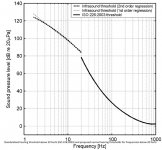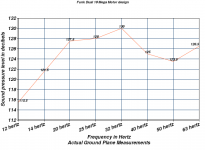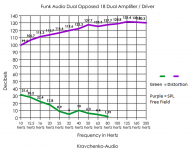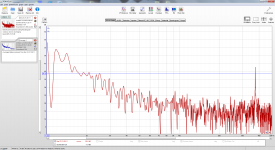Bach On -
Before pursuing dreams of 16 Hz notes and other teen phantasies, you might find out what your organ tone generator outputs at the lowest pedal and whether it is conceivable you could make audible music down there with any affordable speakers in any church bigger than a store-front. I can't claim to know the answers to those questions, but then I am not making big decisions which require the answers before spending a lot of money.
I say this because you are not facing up to life's trade-offs. You are precluding developing a system with muscles where you likely need it, around 24-44 Hz.
What is your motivation for not eyeballing the tone generator electric output (somewhere along the stream) with REW? Are you unconvinced you'd learn something truly crucial?
With all the endless jaw-jaw here, I'd like to see people post FR showing output at 16 Hz for something THEY built. And if you can't, maybe you should moderate your boosterism for Bach On to do so.
Ben
Before pursuing dreams of 16 Hz notes and other teen phantasies, you might find out what your organ tone generator outputs at the lowest pedal and whether it is conceivable you could make audible music down there with any affordable speakers in any church bigger than a store-front. I can't claim to know the answers to those questions, but then I am not making big decisions which require the answers before spending a lot of money.
I say this because you are not facing up to life's trade-offs. You are precluding developing a system with muscles where you likely need it, around 24-44 Hz.
What is your motivation for not eyeballing the tone generator electric output (somewhere along the stream) with REW? Are you unconvinced you'd learn something truly crucial?
With all the endless jaw-jaw here, I'd like to see people post FR showing output at 16 Hz for something THEY built. And if you can't, maybe you should moderate your boosterism for Bach On to do so.
Ben
Last edited:
Bach On -
Before pursuing dreams of 16 Hz notes and other teen phantasies, you might find out what your organ tone generator outputs at the lowest pedal and whether it is conceivable you could make audible music down there with any affordable speakers in any church bigger than a store-front. I can't claim to know the answers to those questions, but then I am not making big decisions which require the answers before spending a lot of money.
I say this because you are not facing up to life's trade-offs. You are precluding developing a system with muscles where you likely need it, around 24-44 Hz.
What is your motivation for not eyeballing the tone generator electric output (somewhere along the stream) with REW? Are you unconvinced you'd learn something truly crucial?
With all the endless jaw-jaw here, I'd like to see people post FR showing output at 16 Hz for something THEY built. And if you can't, maybe you should moderate your boosterism for Bach On to do so.
Ben
It's amusing that you think no one has any experience or common sense.
But I'm glad you asked. Here's some pics of a large tl I built back in 2006 or 2007. It was long before Hornresp could simulate tapped horns but I tried to make it a tapped horn anyway. It didn't work well but I moved the driver to the outside of the cab to make it a regular tl. In that configuration it had flat response down to 16 hz and it did what it was supposed to do. This was long before I had a measurement mic so there are no measurements. It was decommissioned long ago as it was too big and heavy for me to move by myself, I had no need for 16 hz extension and I wanted to use the drivers for other projects and experiments.
https://sites.google.com/site/amateuraudio/projects-1/big-tl
Here's one I built in 2009. It's not 16 hz tuning but it's not that far off and I really have no need for 16 hz tuning. It's a more practical size (65 liters) and it uses a 6 inch driver. As built the tuning turned out a bit lower than expected, around 22 hz. Predicted max spl was about 106 db at the lowest point in the passband in 2 pi space. That's about as far as you can push a 6 inch driver.
https://sites.google.com/site/amateuraudio/projects-1/tapped-horn
Measurement of the little tapped horn taken outside at a distance of about 10 meters at a random power level -
An externally hosted image should be here but it was not working when we last tested it.
And then again with a handful of stuffing in the mouth -
An externally hosted image should be here but it was not working when we last tested it.
This tiny tapped horn with a tiny 6 inch driver is plenty loud enough to be entertaining, right down to the low knee.
There have been other undocumented projects as well both my own and my friend's. So I do have some practical experience with low frequencies. And a whole lot of projects with 27 - 40 hz tuning that all perform as expected.
If you recall, I was recommending eight fully powered high excursion 18's for OP's project as a start, with more to be added as required. I'm a bit surprised that he's satisfied with what he has now but I'm not going to argue with him that his goal is a "teen phantasy" and that it can't possibly be achieved. I know it can be achieved, in fact I guarantee it.
I can't guarantee his building wouldn't undergo some significant structural damage if the system were designed to my spec (if budget allowed I'd recommend 16 - 32 fully powered high excursion 18 inch drivers) but the situation is what it is and he seems satisfied. Why don't you go and measure his system yourself if this reality upsets you so much?
Bach On -
Before pursuing dreams of 16 Hz notes and other teen phantasies, you might find out what your organ tone generator outputs at the lowest pedal and whether it is conceivable you could make audible music down there with any affordable speakers in any church bigger than a store-front. I can't claim to know the answers to those questions, but then I am not making big decisions which require the answers before spending a lot of money.
I say this because you are not facing up to life's trade-offs. You are precluding developing a system with muscles where you likely need it, around 24-44 Hz.
What is your motivation for not eyeballing the tone generator electric output (somewhere along the stream) with REW? Are you unconvinced you'd learn something truly crucial?
With all the endless jaw-jaw here, I'd like to see people post FR showing output at 16 Hz for something THEY built. And if you can't, maybe you should moderate your boosterism for Bach On to do so.
Ben
Ben,
I am currently at home. The organ is not here. I will go to the church tomorrow night for choir practice. That's where the organ is located. I plan to stay at the church after the rehearsal to do the measurements you've suggested. I'm trying to make sure I have the right plugs to run the test.
I also had to go today and buy and install a new battery for my car that I'll need to go to the church where the organ is located. These types of things happen to me sometimes. In the meantime, I have been asking questions on the forum from my home. Did I mention that the organ is not here? 😛
BTW, yesterday was J.S. Bach's Birthday. He was born in 1685.
Bach On
Bach was a great techie as well as a great performer.
I'll play the trio sonatas to celebrate his birthday.
Ben
I'll play the trio sonatas to celebrate his birthday.
Ben
If anyone sees anything listing a Stereo Integrity HT18 woofer being offered for sale, I'd like to know about it. I'd prefer the 2 ohm version, but I'd consider the 4 ohm.
Thanks!
Bach On
Thanks!
Bach On
Your turn Ben. Show a measurement of something you built that can play low frequencies. An indoors eq'ed measurement of your antique garage sale woofer doesn't count.
Guys,
I connected the pedal output of the Artisan sound engine to my computer's Line In. Ran REW while I had a MIDI file play notes in the lowest octave. Used the 32 foot Contra Bourdon stop.
I'm still not overly comfortable with REW. But for good or for ill, here is what I got.
IF THIS UPLOADS CORRECTLY, there should be three files.
Seems like I had a problem doing this upload before. But this is a zipped set of 3 files. One is a RTA file. The other two are files for REW.
Perhaps some of you experts can tell me a better way to do this.
View attachment Re__12_inch_Front_Loaded_Horn_Subwoofer(1).zip
Bach On
I connected the pedal output of the Artisan sound engine to my computer's Line In. Ran REW while I had a MIDI file play notes in the lowest octave. Used the 32 foot Contra Bourdon stop.
I'm still not overly comfortable with REW. But for good or for ill, here is what I got.
IF THIS UPLOADS CORRECTLY, there should be three files.
Seems like I had a problem doing this upload before. But this is a zipped set of 3 files. One is a RTA file. The other two are files for REW.
Perhaps some of you experts can tell me a better way to do this.
View attachment Re__12_inch_Front_Loaded_Horn_Subwoofer(1).zip
Bach On
Off to a good start. Congrats.
I could open three frequency spectrums in REW. Couldn't make sense of them but if they had little peaks at 60 Hz (which they don't), they would resemble noise spectra or maybe a whole lot of notes added together.
The download with ".rta" wouldn't open on my Mac. If anybody can recode to another format, much appreciated. The RTA is the display you want to see what the tone generator is putting out.
With REW, you set the RTA to cumulate and then play something for a few seconds, and then freeze it by un-hitting the trigger button (upper right corner). Then take a snapshot (upper left area above "db"). That ought to produce a quite clear notion of what the tone generator is putting out.
Ben
I use the RTA all the time to see what low notes are on my recordings.... since I know you can't judge too well by ear. Actually, I know other people can't tell by ear, but I didn't want to put it that way.
I could open three frequency spectrums in REW. Couldn't make sense of them but if they had little peaks at 60 Hz (which they don't), they would resemble noise spectra or maybe a whole lot of notes added together.
The download with ".rta" wouldn't open on my Mac. If anybody can recode to another format, much appreciated. The RTA is the display you want to see what the tone generator is putting out.
With REW, you set the RTA to cumulate and then play something for a few seconds, and then freeze it by un-hitting the trigger button (upper right corner). Then take a snapshot (upper left area above "db"). That ought to produce a quite clear notion of what the tone generator is putting out.
Ben
I use the RTA all the time to see what low notes are on my recordings.... since I know you can't judge too well by ear. Actually, I know other people can't tell by ear, but I didn't want to put it that way.
Last edited:
If you take a screenshot of the measurement anyone can view it.
I use the RTA all the time to see what low notes are on my recordings.... since I know you can't judge too well by ear. Actually, I know other people can't tell by ear, but I didn't want to put it that way.
Very few people can tell by ear, even trained listeners can be unreliable and can be fooled by tricks.
I use Audacity to analyze tracks to find the low note frequencies.
This might be an option too if you can't get good results with REW. Record a WAV file and analyze it with Audacity. It's really easy.
Last edited:
Don't look like it to me. Hard to say where the organ company puts its bets - based on their ears and what they think will work for their customers (meaning, not trying to press the issue by outputting too much below 30 Hz).
For sure, the spectrum would have clear bumps for the note (and maybe louder for the harmonics, not kidding) and the bits and pieces that give it organ-pipe character.
My guess.
Ben
For sure, the spectrum would have clear bumps for the note (and maybe louder for the harmonics, not kidding) and the bits and pieces that give it organ-pipe character.
My guess.
Ben
What you have to do is think a bit on how music and sound co-exist.
Our hearing is less acute as the frequency lessens. therefore the size of the pipe on some stops is increased not only in length as the tone lowers but also in the cross section.
Reasons why are rather simple. They get louder. But they can sound pretty much equal in volume due to our lessened acuity.
Behold:

Threshold of audibility for the low to exceedingly low end of our hearing.
Our hearing is less acute as the frequency lessens. therefore the size of the pipe on some stops is increased not only in length as the tone lowers but also in the cross section.
Reasons why are rather simple. They get louder. But they can sound pretty much equal in volume due to our lessened acuity.
Behold:

Threshold of audibility for the low to exceedingly low end of our hearing.
I didn't have the right cables and patch cords to do what I did AND measure the output of the speakers at the same time. Considering my inexperience with REW, I guess it wasn't too terrible.
But to my uncultured eye this does seem to support that the Artisan is putting out the signals down to 16 Hz.
Thanks to Mark for his analysis. I'll try to do some more for Ben.
I use Tru RTA because it was suggested to me by an organ tech friend. I have heard of Audacity, but I've never used it. I have had it several times, however.
Bach On
P.S. The iNuke3000DSP came today. But I still haven't received the Samson PreAmp. I may try out the iNuke tonight after our Maundy Thursday Service. It has an adjustment for the input signal strength. And it will still have more power that the XLS1500. I figure it's worth a try. It lists a frequency response of 20 to 20K Hz. Maybe the DSP can be used to work around that a bit for the frequencies just below 20 Hz..Or not.
But to my uncultured eye this does seem to support that the Artisan is putting out the signals down to 16 Hz.
Thanks to Mark for his analysis. I'll try to do some more for Ben.
I use Tru RTA because it was suggested to me by an organ tech friend. I have heard of Audacity, but I've never used it. I have had it several times, however.
Bach On
P.S. The iNuke3000DSP came today. But I still haven't received the Samson PreAmp. I may try out the iNuke tonight after our Maundy Thursday Service. It has an adjustment for the input signal strength. And it will still have more power that the XLS1500. I figure it's worth a try. It lists a frequency response of 20 to 20K Hz. Maybe the DSP can be used to work around that a bit for the frequencies just below 20 Hz..Or not.
If that measurement is accurate you have a lot of output below your enclosure tuning frequency. This could damage the drivers. Ideally you should be using a high pass filter or tuning the enclosures lower.
Don't look like it to me. Hard to say where the organ company puts its bets - based on their ears and what they think will work for their customers (meaning, not trying to press the issue by outputting too much below 30 Hz).
For sure, the spectrum would have clear bumps for the note (and maybe louder for the harmonics, not kidding) and the bits and pieces that give it organ-pipe character.
My guess.
Ben
As I understand it, it was clearly explained that the organ company puts it's bets on a recorded sample - based on a real organ recording.
There is a pretty clear bump at about 15 hz. I'm surprised to also see an even bigger bump at 12 hz, wasn't expecting that, and not sure what's going on at 10 hz. But if the measurement is accurate it seems like it puts out low bass for sure.
As I understand it, it was clearly explained that the organ company puts it's bets on a recorded sample - based on a real organ recording.
There is a pretty clear bump at about 15 hz. I'm surprised to also see an even bigger bump at 12 hz, wasn't expecting that, and not sure what's going on at 10 hz. But if the measurement is accurate it seems like it puts out low bass for sure.
Yep the fun and games of what actually happens versus what we thought might be happening.
Fascinating that the signals out are that low for a supposedly lowest pitch of about 16.8 hertz for a 32 foot C.
Now we need to look at the actual tuning of the boxes to see if they can handle this without any hiccups.
Many times the actual tuning frequency is lower than computed so this might not be as dangerous as it seems.
What about that hint of a massive spike at 10 hz? Measurement glitch? Or is it really there?
I agree that it's time to find out what the exact tuning turned out to be (unless OP wants to use a hpf in which case it doesn't really matter much, although it's always nice to know anyway), and it might be tuned lower than 16 hz but I doubt it's anywhere near 10.
If this thing is putting out huge spikes of noise at 10 hz and lower it could cause all kinds of problems.
I agree that it's time to find out what the exact tuning turned out to be (unless OP wants to use a hpf in which case it doesn't really matter much, although it's always nice to know anyway), and it might be tuned lower than 16 hz but I doubt it's anywhere near 10.
If this thing is putting out huge spikes of noise at 10 hz and lower it could cause all kinds of problems.
- Status
- Not open for further replies.
- Home
- Loudspeakers
- Subwoofers
- Tapped Horn Cabinet for 16 Hz. organ speaker


